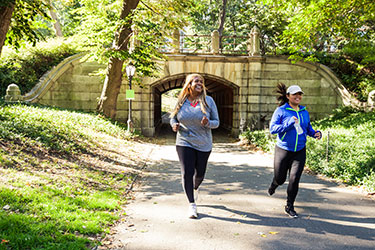Parks and green spaces encourage physical activity, improve social cohesion, boost mental health and more. Yet lack of access and availability, as well as racist practices like redlining and over-policing, mean not every community gets to take advantage of such benefits.
At a Tuesday APHA 2021 session on “Parks and Public Spaces: Working to Achieve Health Equity,” presenters shared how they work to increase park equity and how we can collaboratively work together to achieve health equity.
 Among Black Americans, the influence of structural racism means inequitable access to nature and its many benefits, said Jennifer Roberts of with the University of Maryland. Born in Buffalo, New York, Roberts said her mother remembers loving her walks in Humboldt Park, which was connected to Delaware Park by a beautiful tree-lined boulevard in Buffalo’s predominantly Black East Side community.
Among Black Americans, the influence of structural racism means inequitable access to nature and its many benefits, said Jennifer Roberts of with the University of Maryland. Born in Buffalo, New York, Roberts said her mother remembers loving her walks in Humboldt Park, which was connected to Delaware Park by a beautiful tree-lined boulevard in Buffalo’s predominantly Black East Side community.
“But by the time I was born, this was Kensington Highway, an expressway from downtown to the suburbs built in the 1960s, as a result of white flight and urban renewal,” Roberts told session attendees. The highway displaced residents, divided the neighborhood and destroyed the park land designed by renowned landscape architect Frederick Law Olmsted in the late 1800s.
“We have to look at structural racism, exclusion, white privilege and how they intersect with nature connectedness and health equity,” she said. “There’s been a lack of attention to Black outdoor spaces. We need to restore Mother Nature to everyone.”
Anne Petri, with the National Association for Olmsted Parks, spoke about how Frederick Law Olmsted’s driving force was his belief that parks and green spaces belong to everyone. “Parks are not luxuries,” he said. “They are essential to our ecological, social and healthy well-being.”
With next year marking Olmsted’s 200th birthday, APHA is one of the founding partners of the Olmsted 200 campaign, which seeks to engage diverse audiences about the enduring influence of Olmsted’s democratic values, as well as his legacy of landscape design.
“The bicentennial is not just a celebration, but a call to action,” Petri said during the session. “Olmsted 200 offers a timely opportunity to recommit to investment in the revitalization of our historic parks and places for future generations, to reimagine and sustain park equity, parks that are inclusive, verdant and vibrant for all communities.”
Presenter Autumn Saxton-Ross, vice president of education and chief equity officer at the National Recreation and Park Association, shared how the association is centering equity and inclusion using a DEI Framework. “The COVID-19 pandemic has show us how essential parks and recreation are to mind, body and spirit,” she said.
Na'Taki Osborne Jelks, of the West Atlanta Watershed Alliance in Georgia, offered a local perspective, highlighting how the community-based organization has preserved over 400 acres of green space from development in southwest Atlanta, thanks to community mobilization and support.
“Parks and green spaces — playgrounds, pocket parks, trails, gardens, outdoor recreation facilities, open spaces and green infrastructure — are crucial for community health and well-being,” said Rachel Bennett, who manages People, Parks and Power: A National Initiative for Green Space, Health Equity and Racial Justice at the Prevention Institute. “To address inequities, including park inequities, we need to change our process in order to change the outcome.”
Two women run in New York City’s Central Park, one of the many public parks designed by Frederick Law Olmstead. Photo by LeoPatrizi, iStockphoto.